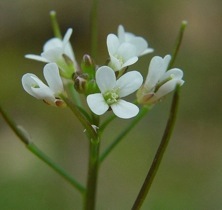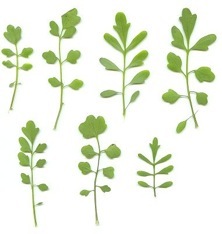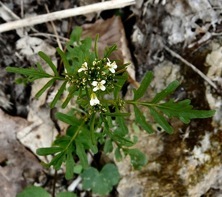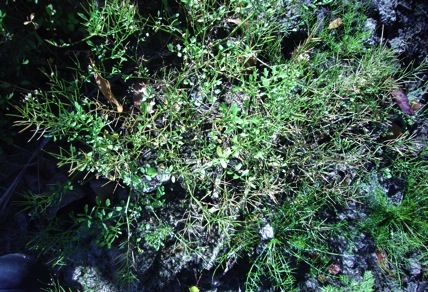Cardamine pensylvanica: Petite Pot Herb
The first time I saw Bittercress I knew it had to be an edible. I just didn’t know which one.
How did I know? Plants are in families and it looked like a lot of wild edible plants in the Brassica family, or Cruciferae: Scrawny, leggy, skinny little leaves, minute four-petaled flowers, seeds in a pod on stems, peppery leaves. The only odd element was I found it in very wet soil, next to a stream. Come to find out, it likes rich, damp soil, and a close relative that looks very much alike, likes dry terrain.
 Cardamine pensylvanica (yes one “N” in pensylvanica thanks to the dead language of Latin) really isn’t bitter, or at least the ones I’ve had haven’t been. Actually several Cardamines are available in the United States and at least four in Florida, C. pensylvanica, C. parvifolia, C flexuosa and C. concatenata. Other ones found and consumed in the U.S. are C. hirsuta, C. amara, C. oligosperma and C. pratensis, for leaves; and C. rhomboidea and C. diphylla for their leaves and/or roots.
Cardamine pensylvanica (yes one “N” in pensylvanica thanks to the dead language of Latin) really isn’t bitter, or at least the ones I’ve had haven’t been. Actually several Cardamines are available in the United States and at least four in Florida, C. pensylvanica, C. parvifolia, C flexuosa and C. concatenata. Other ones found and consumed in the U.S. are C. hirsuta, C. amara, C. oligosperma and C. pratensis, for leaves; and C. rhomboidea and C. diphylla for their leaves and/or roots.
It is not at all unusual for the roots of such plants to be ground up and mixed with vinegar and salt to make a horseradish kind of sauce. I’ve done it often with the roots of the Lepidium virginicum, or Poor Man’s Pepper Grass.
 If you find a Cardamine in Florida growing where it is quite dry it is probably the C. parvifolia. If wet, then probably the C. hirsuta (see separate entry.) Incidentally, there are four endangered species of Cardamine in the U.S. (C. constancei, C. incisa, C. micranthera and C. pattersonii) so harvest conscientiously.
If you find a Cardamine in Florida growing where it is quite dry it is probably the C. parvifolia. If wet, then probably the C. hirsuta (see separate entry.) Incidentally, there are four endangered species of Cardamine in the U.S. (C. constancei, C. incisa, C. micranthera and C. pattersonii) so harvest conscientiously.
While C. pensylvanica is the most common locally the only native one is C. concatenata, or Cutleaf Bittercress. The Iroquois used it as food, raw, with salt or cooked. It was also used as a medicine. They mashed the roots and used them to treat headaches, colds, to encourage the appetite, for heart problems and injuries. It was also considered slightly hallucinogenic.
 The botanical name, Cardamine pensylvanica, is said kar-DAM-in-ee pen-sil-VAN-ee-ka. You will also see kar-da-MY-neez, which is the British way of saying it. Cardamine is from the Greek word kardamis, for a kind of cress. Contemporary Greeks call cress κάδαμο (KAR-tha-moe.) Pensylvanica means “of Pennsylvania, or Eastern North America. Parvifolia (par-vee-FOH-lee-uh) means small leaf. Concatenata (kon-kan-teh-NAH-tuh) means linked or chained together. Hirsuta means hairy, referring to the lower stems.
The botanical name, Cardamine pensylvanica, is said kar-DAM-in-ee pen-sil-VAN-ee-ka. You will also see kar-da-MY-neez, which is the British way of saying it. Cardamine is from the Greek word kardamis, for a kind of cress. Contemporary Greeks call cress κάδαμο (KAR-tha-moe.) Pensylvanica means “of Pennsylvania, or Eastern North America. Parvifolia (par-vee-FOH-lee-uh) means small leaf. Concatenata (kon-kan-teh-NAH-tuh) means linked or chained together. Hirsuta means hairy, referring to the lower stems.
Thee are some 150 species in the genus and are found at every location on the rotation except the Antarctic. The leaves vary greatly from plant to plant, species to species, from minute to medium-sized, pinnate to bipinnate, basal to cauline (growing on the upper part of the stem.) The edges of the leaves smooth or toothy. And you have just to got to love those arguing botanists. The genus Dentaria and the genus Cardamine are the same genus, just different egos at conflict.
Under cultivation C. pensylvanica can be coaxed to grow to more than a yard high and wide. A perennial herb, it can be trained into round shrub. Oddly, when raised intentionally it does not like to be wet and one has to water it moderately.
Green Deane’s “Itemized” Plant Profile
IDENTIFICATION:
Scraggly plant to two feet, weak taproot, flowers white, tiny, about 1/16 to 1/8 inch across. Silique seed pods, elongate, narrow, middle membrane, many seeds. Basal leaves and middle leaves long, deeply lobed, with great variation. Leaves have three distinct veins. Stems multiple, upright or spreading, branched, green to purplish, round to angled in cross-section, hairy towards base. Upper stem can be non-hair, lower stem can have fuzz.
TIME OF YEAR:
Flowers April to October, leaves and seed pods for several months
ENVIRONMENT:
C. pensylvanica prefers wet feet, C. parvifolia likes it dry
METHOD OF PREPARATION:
Young leaves raw, older leaves cooked, seed pods raw or pickled, some roots can make a good horseradish substitute.


